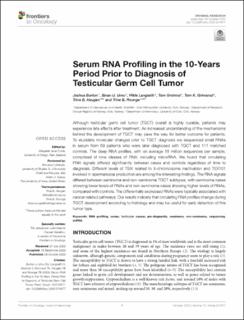| dc.contributor.author | Burton, Joshua | |
| dc.contributor.author | Umu, Sinan Uğur | |
| dc.contributor.author | Langseth, Hilde | |
| dc.contributor.author | Grotmol, Tom | |
| dc.contributor.author | Grimsrud, Tom Kristian | |
| dc.contributor.author | Haugen, Trine B. | |
| dc.contributor.author | Rounge, Trine Ballestad | |
| dc.date.accessioned | 2021-05-25T13:13:58Z | |
| dc.date.available | 2021-05-25T13:13:58Z | |
| dc.date.created | 2020-09-23T15:30:40Z | |
| dc.date.issued | 2020-10-28 | |
| dc.identifier.citation | Frontiers in Oncology. 2020, 10, (1-13). | en_US |
| dc.identifier.issn | 2234-943X | |
| dc.identifier.uri | https://hdl.handle.net/11250/2756335 | |
| dc.description.abstract | Although testicular germ cell tumor (TGCT) overall is highly curable, patients may experience late effects after treatment. An increased understanding of the mechanisms behind the development of TGCT may pave the way for better outcome for patients. To elucidate molecular changes prior to TGCT diagnosis we sequenced small RNAs in serum from 69 patients who were later diagnosed with TGCT and 111 matched controls. The deep RNA profiles, with on average 18 million sequences per sample, comprised of nine classes of RNA, including microRNA. We found that circulating RNA signals differed significantly between cases and controls regardless of time to diagnosis. Different levels of TSIX related to X-chromosome inactivation and TEX101 involved in spermatozoa production are among the interesting findings. The RNA signals differed between seminoma and non-seminoma TGCT subtypes, with seminoma cases showing lower levels of RNAs and non-seminoma cases showing higher levels of RNAs, compared with controls. The differentially expressed RNAs were typically associated with cancer related pathways. Our results indicate that circulating RNA profiles change during TGCT development according to histology and may be useful for early detection of this tumor type. | en_US |
| dc.description.sponsorship | Internal funds of OsloMet—Oslo Metropolitan University and Cancer Registry of Norway. | en_US |
| dc.language.iso | eng | en_US |
| dc.publisher | Frontiers Media | en_US |
| dc.relation.ispartofseries | Frontiers in Oncology;volume 10 | |
| dc.rights | Navngivelse 4.0 Internasjonal | * |
| dc.rights.uri | http://creativecommons.org/licenses/by/4.0/deed.no | * |
| dc.subject | RNA profiling | en_US |
| dc.subject | Serum | en_US |
| dc.subject | Testicular cancer | en_US |
| dc.subject | Seminoma | en_US |
| dc.subject | Non-seminoma | en_US |
| dc.subject | Sequencing | en_US |
| dc.subject | miRNA | en_US |
| dc.title | Serum RNA profiling in the 10-year period prior to diagnosis of testicular germ cell tumour | en_US |
| dc.type | Peer reviewed | en_US |
| dc.type | Journal article | en_US |
| dc.description.version | publishedVersion | en_US |
| dc.rights.holder | Copyright © 2020 Burton, Umu, Langseth, Grotmol, Grimsrud, Haugen and Rounge. | en_US |
| dc.source.articlenumber | 574977 | en_US |
| cristin.ispublished | true | |
| cristin.fulltext | original | |
| cristin.qualitycode | 1 | |
| dc.identifier.doi | https://doi.org/10.3389/fonc.2020.574977 | |
| dc.identifier.cristin | 1832663 | |
| dc.source.journal | Frontiers in Oncology | en_US |
| dc.source.volume | 10 | en_US |
| dc.source.pagenumber | 1-13 | en_US |
| dc.relation.project | Norges forskningsråd: 229621/H10 | en_US |
| dc.relation.project | Norges forskningsråd: 248791/H10 | en_US |

